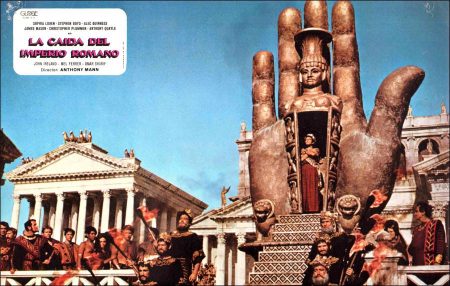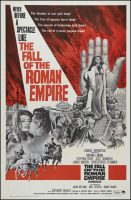The Fall of the Roman Empire movie storyline. Intent on securing peace and prosperity throughout the mighty Roman Empire, the wise diplomat, Emperor Marcus Aurelius, calls together the local governors from all over the Empire, after conquering the Germanic tribes. With this in mind, Marcus has decided to turn over his crown and the much-coveted imperial throne to General Livius, instead of choosing his corrupt son and logical successor, Commodus.
As a result, high treason and blind ambition lead to the death of Aurelius by poisoning, paving the way for a new era of oppression, endless machinations, and rapid decline. Now, as darkness prevails on the outskirts of the Empire where the Roman legions struggle to subdue the invading hordes, delusional Commodus declares himself a god, and no one is safe; not even Aurelius’ daughter, Lucilla. Can anyone stop the fall of the Roman Empire?
The Fall of the Roman Empire is a 1964 American epic film directed by Anthony Mann and produced by Samuel Bronston, with a screenplay by Ben Barzman, Basilio Franchina and Philip Yordan. The film stars Sophia Loren, Stephen Boyd, Alec Guinness, James Mason, Christopher Plummer, Mel Ferrer, and Omar Sharif.
The film’s plot is only loosely based on actual historical events. However, in the long-established view of Roman history, Marcus Aurelius is considered as the last of the Five Good Emperors whose time is considered the best of Roman imperial history. Commodus is generally considered to have fallen far below the standard set by his father and the four earlier Emperors, and his reign is considered as the beginning of the decline – though that would still take several centuries.
When filming for El Cid (1961) had finished, Anthony Mann saw a copy of Edward Gibbon’s six-volume series The History of the Decline and Fall of the Roman Empire inside the Hatchards bookshop. He pitched a film adaptation of the book to Samuel Bronston, who then agreed to produce the project. Philip Yordan was enlisted to write the script while Charlton Heston was initially set to star.
However, Heston backed out of the film and agreed to star in 55 Days at Peking (1963). Prominent actors were cast to portray multiple roles in the film. The final screenplay was written by Ben Barzman and Basilio Franchina with a prologue written by historian Will Durant. Filming began in January 1963 and wrapped in July. Additionally, the film features the largest outdoor film set in the history of film, a 92,000 m2 replica of the Roman Forum.
The film’s name refers not to the final fall of the Roman empire, which did in fact survive for centuries after the period depicted in the film, but rather to the onset of corruption and decadence which led to Rome’s final demise. It deals extensively with the problem of imperial succession, and examines both the relationship between father and son on the background of imperial politics as well as the nature and limits of loyalty and friendship.
On March 24, 1964, the film premiered at the London Astoria. Critics criticized the script as void of emotion and humanity and the directing as misguided, but showed some praise for the large spectacles. The film was a financial failure at the box-office.
About the Production
Principal photography began on January 14, 1963. Marcus Aurelius’s winter camp on the Danube was shot on location in the snow along the Sierra de Guadarrama in northern Madrid. The “Battle of the Four Armies” involved 8,000 soldiers including 1,200 cavalry and was shot on an undulating plain at Manzanares el Real which allowed large numbers of soldiers to be visible over a long distance.
Meanwhile, Yakima Canutt had been hired as the second unit director at the insistence of Mann. As he had done in El Cid (1961), Canutt performed his own stunts while his son Tap served as the stunt double for Stephen Boyd. Jack Williams served as the body double for Christopher Plummer. Among the first scenes shot was the chariot race sequence between Livius and Commodus. 1,500 horses were gathered from Spain and Portugal for which they were trained to fall safety during the battle sequences.
Interior scenes were shot in Madrid at the Samuel Bronston Studios (formerly known as the Charmartin Studios) and at the Cinecittà Studios in Rome where Commodus’s baths and gymnasiums were constructed. Filming had been arranged to shoot at Cinecittà in order to make it eligible for government subsidies. In July 1963, filming was finished after 143 days. Second unit directors Canutt and Andrew Marton spent an additional 63 days shooting the action sequences.
Veniero Colasanti and John Moore served as the art directors overseeing the production design with the guidance of Will Durant. Actual construction began on October 1, 1962 using 1,100 men who labored for seven months. About 400 art students and craftsmen throughout Spain worked on the statuary, tiles, frescoes, and details of the set. The film’s reconstruction of the Roman Forum was constructed in Las Matas near Madrid, approximately sixteen miles from Bronston’s studio. The entire set was measured at 400 x 30 meters (1312 x 754 feet), which holds the record for the largest outdoor film set. Uniquely for the film, the set was not extended through the use of matte paintings.
The Temple of Jupiter was constructed on a 95-foot high hill along the plains of Las Matas by which craftsmen built the 165-foot temple on it. The bronze equestrian figures at the top of the temple were 260 feet above the pavement of the forum set. For the statuary, 350 statues had to be constructed. There were 76 life-size statutes, more than a thousand sculpted bases for the remaining figures and victory columns, and a series of the aforementioned equestrian statues that were 25 feet high. Ultimately, more than 3,000 sketches were drawn to illustrate the 27 structures that would comprise the sets. The various ancient Rome settings covered 55 acres (220,000 m2). After much of the set was pulled down, remaining sections of the set were reused in A Funny Thing Happened on the Way to the Forum (1966).
Dimitri Tiomkin’s score, which is one of the notable features of the film, is more than 150 minutes in length. It is scored for a large orchestra, including an important part for cathedral organ. Several cues are extended compositions in their own right. These include Pax Romana in which Marcus Aurelius summons the governors of all the Roman provinces. Although Christopher Palmer stated in his book on film music, The Composer in Hollywood, that it was a march, the cue is actually in the style of a bolero.
Other notable cues include those for The Roman Forum, composed to accompany Commodus’s triumphal return to Rome as the newly installed Emperor; a percussive scherzo for a barbarian attack by Ballomar’s army; the Tarantella danced by the Roman mob on the evening presaging the gladiatorial combat between Livius and Commodus (which seems to be modelled on the Tarantella movement from the Piano Concerto of Tiomkin’s teacher Ferruccio Busoni).
The music was recorded at the Royal Albert Hall. The music editor was George Korngold, son of Erich Wolfgang Korngold. A soundtrack album was released by Columbia Records to coincide with the release of the film.
The Fall of the Roman Empire (1964)
Directed by: Anthony Mann
Starring: Sophia Loren, Stephen Boyd, Alec Guinness, James Mason, Christopher Plummer, Mel Ferrer, Omar Sharif, Anthony Quayle, John Ireland, Eric Porter, Finlay Currie, Andrew Keir
Screenplay by: Ben Barzman, Basilio Franchina, Philip Yordan
Production Design by: Veniero Colasanti, John Moore
Cinematography by: Robert Krasker
Film Editing by: Robert Lawrence
Costume Design by: Veniero Colasanti, John Moore
Set Decoration by: Veniero Colasanti, John Moore
Music by: Dimitri Tiomkin
MPAA Rating: None.
Distributed by: Paramount Pictures
Release Date: March 24, 1964 (UK), March 26, 1964 (US)
Views: 520




